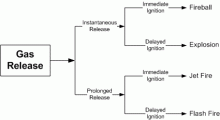Event Tree Analysis

Overview
Event Tree Analysis (ETA) uses the same logical and mathematical techniques as Fault Tree Analysis. However, whereas a fault tree analyzes how an undesirable top event may occur, an event tree considers the impact of the failure of a particular component or item in the system, and works out the effect such a failure will have on the overall system risk or reliability. Event trees use an inductive approach, whereas fault trees are deductive. Event trees were developed for the nuclear industry. They are much less widely used in the process industries.
The initiating event in an event tree will usually fall into one of the following four categories:
- Failures or unsafe conditions in individual items of equipment;
- Human error;
- Utility failures; and
- External events (such as hurricanes or earthquakes).
The sketch shows an event tree for a situation in which the pressure in a vessel rises.
Event Tree Example
The tree starts with the event “High Pressure in the Vessel”. The reasons for the occurrence of this event are not explained. There are four layers of protection, each of which has a chance of either success or failure. At the first junction the normal control system acts. If it brings the pressure to a safe state then there is no need to continue with the development of the tree. Therefore the “Success” lines are dashed, showing that they do not need to be considered.
Event tree analysis is an example of inductive analysis. It uses the same logical and mathematical techniques as Fault Tree Analysis. However, whereas a fault tree analyzes how an undesirable top event may occur, an event tree considers the impact of the failure of a particular component or item in the system, and works out the effect such a failure will have on the overall system risk or reliability. Event trees use an inductive approach, whereas fault trees are deductive.
Video
The seven minute YouTube video shown at the bottom of this page also describes the topic of Event Tree Analysis.
